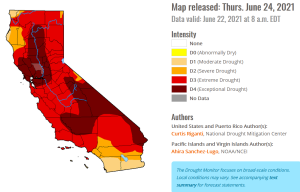The U.S. Drought Monitor map released June 10, 2021 shows much of the West ranging from extreme to exceptional drought. Lake Mead has fallen to its lowest level since it filled in 1937, which may necessitate reduced water supplies for Nevada, Arizona and Mexico in 2022.
Locally, if you look up your water agency’s website, you will find links to information about water efficiency and wise use. Tuolumne Utilities District (TUD) provides water use efficiency legislation information and an introduction to the Landowner Resiliency Program with a toolkit including climate appropriate landscaping here.
We are approaching July – Smart Irrigation Month – when the evaporation rate is highest in the foothills and the month when our plants typically use the most water.
Celebrate “Smart Irrigation Month” by using some of the watering tips from the University of California Integrated Pest Management program, http://ipm.ucanr.edu/TOOLS/TURF/
Reduce your landscape’s need for water. Choose water-efficient plants and garden designs. http://www.watertoolkit.org/?page_id=1904
Avoid planting turf species that require frequent watering, such as bluegrass or ryegrass. Try one of the new strains of buffalo grass that can be watered as little as twice a month. Water only when your lawn needs water, deeper and less frequently.
Urban Drool is Not Cool. Don’t let your sprinklers/sprayers produce run-off. Adjust the direction of sprinkler heads; replace broken heads and leaking valves.
Cut back on fertilizer. The more you fertilize, the more water your plants require to maintain that excess growth. Many non-flowering trees and shrubs NEVER require fertilizer.
Trees Speaking of trees, never wet the trunk of a tree when irrigating. Water deeply around the dripline. Most established trees and shrubs only need once-a-month watering.
Water early in the morning or late at night to reduce evaporation.
Mulch, mulch, mulch, mulch! A layer of mulch on the ground reduces evaporation, conserves water, stabilizes soil temperature and crowds out weeds.
Plant thickly. There’s a reason Native Americans planted the three sisters of corn, beans and squash. Those large squash leaves shade the soil, conserving precious water and reducing evaporation.
Watering Improve watering efficiency and distribution by using drip irrigation and soaker hoses to take water only where it’s needed.
Rebecca Miller-Cripps is a University of California Cooperative Extension Master Gardener of Tuolumne County who was amazed when she first saw extensive stands of broom plants in the Santa Cruz Mountains in the 1970s.
UCCE Master Gardeners of Tuolumne and Calaveras Counties can answer home gardening questions. Call 209-533-5912 or fill out our easy-to-use problem questionnaire here. Check out our website here. You can also find us on Facebook.

